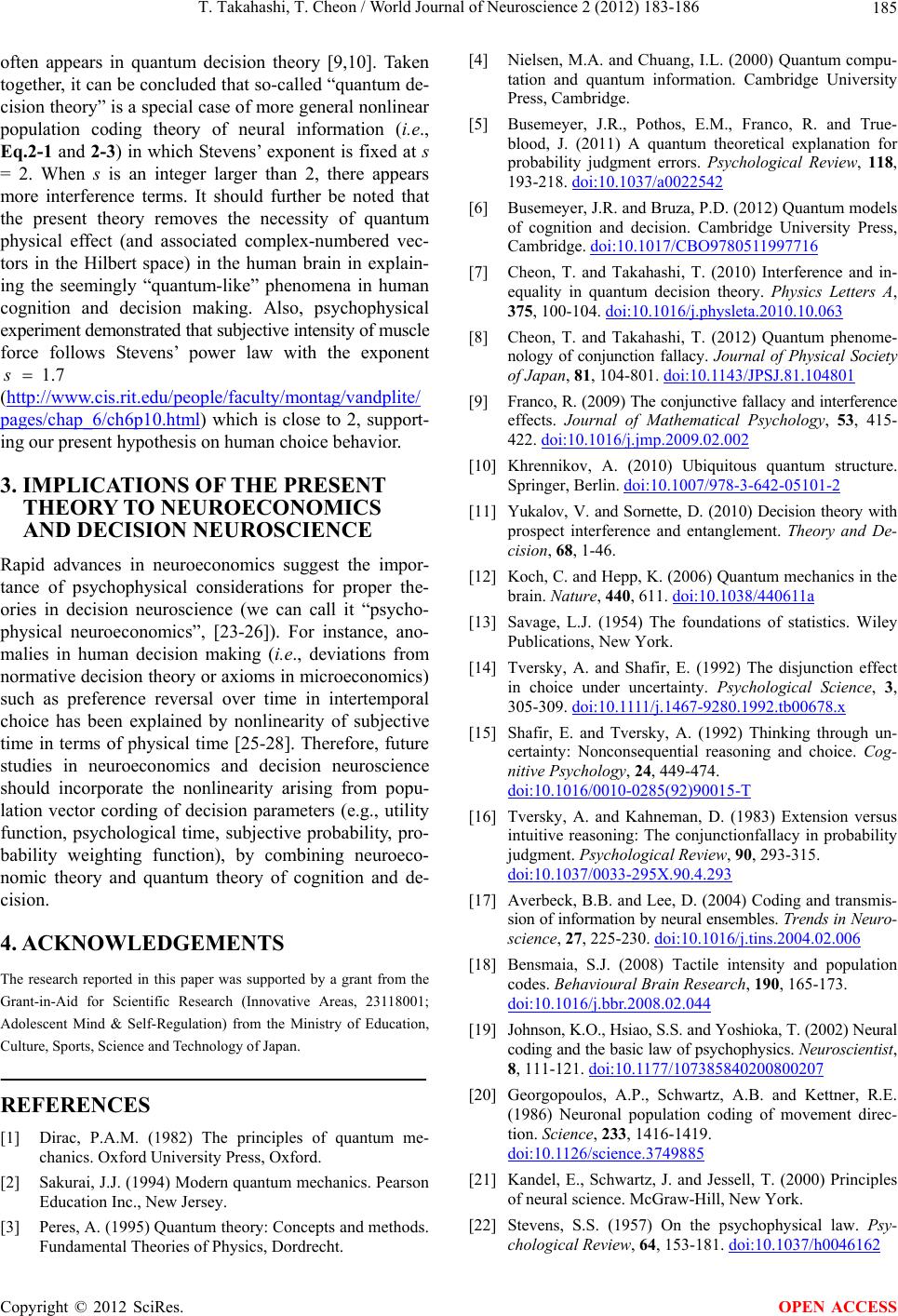
T. Takahashi, T. Cheon / World Journal of Neuroscience 2 (2012) 183-186 185
often appears in quantum decision theory [9,10]. Taken
together, it can be concluded that so-called “quantum de-
cision theory” is a special case of more general nonlinear
population coding theory of neural information (i.e.,
Eq.2-1 and 2-3) in which Stevens’ exponent is fixed at s
= 2. When s is an integer larger than 2, there appears
more interference terms. It should further be noted that
the present theory removes the necessity of quantum
physical effect (and associated complex-numbered vec-
tors in the Hilbert space) in the human brain in explain-
ing the seemingly “quantum-like” phenomena in human
cognition and decision making. Also, psychophysical
experiment demonstrated that subjective intensity of muscle
force follows Stevens’ power law with the exponent
(
1.7s
http://www.cis.rit.edu/people/faculty/montag/vandplite/
pages/chap_6 /ch6p10.ht ml) which is close to 2, support-
ing our present hypothesis on human choice behavior.
3. IMPLICATIONS OF THE PRESENT
THEORY TO NEUROECONOMICS
AND DECISION NEUROSCIENCE
Rapid advances in neuroeconomics suggest the impor-
tance of psychophysical considerations for proper the-
ories in decision neuroscience (we can call it “psycho-
physical neuroeconomics”, [23-26]). For instance, ano-
malies in human decision making (i.e., deviations from
normative decision theory or axioms in microeconomics)
such as preference reversal over time in intertemporal
choice has been explained by nonlinearity of subjective
time in terms of physical time [25-28]. Therefore, future
studies in neuroeconomics and decision neuroscience
should incorporate the nonlinearity arising from popu-
lation vector cording of decision parameters (e.g., utility
function, psychological time, subjective probability, pro-
bability weighting function), by combining neuroeco-
nomic theory and quantum theory of cognition and de-
cision.
4. ACKNOWLEDGEMENTS
The research reported in this paper was supported by a grant from the
Grant-in-Aid for Scientific Research (Innovative Areas, 23118001;
Adolescent Mind & Self-Regulation) from the Ministry of Education,
Culture, Sports, Science and Technology of Japan.
REFERENCES
[1] Dirac, P.A.M. (1982) The principles of quantum me-
chanics. Oxford University Press, Oxford.
[2] Sakurai, J.J. (1994) Modern quantum mechanics. Pearson
Education Inc., New Jersey.
[3] Peres, A. (1995) Quantum theory: Concepts and methods.
Fundamental Theories of Physics, Dordrecht.
[4] Nielsen, M.A. and Chuang, I.L. (2000) Quantum compu-
tation and quantum information. Cambridge University
Press, Cambridge.
[5] Busemeyer, J.R., Pothos, E.M., Franco, R. and True-
blood, J. (2011) A quantum theoretical explanation for
probability judgment errors. Psychological Review, 118,
193-218. doi:10.1037/a0022542
[6] Busemeyer, J.R. and Bruza, P.D. (2012) Quantum models
of cognition and decision. Cambridge University Press,
Cambridge. doi:10.1017/CBO9780511997716
[7] Cheon, T. and Takahashi, T. (2010) Interference and in-
equality in quantum decision theory. Physics Letters A,
375, 100-104. doi:10.1016/j.physleta.2010.10.063
[8] Cheon, T. and Takahashi, T. (2012) Quantum phenome-
nology of conjunction fallacy. Journal of Physical Society
of Japan, 81, 104-801. doi:10.1143/JPSJ.81.104801
[9] Franco, R. (2009) The conjunctive fallacy and interference
effects. Journal of Mathematical Psychology, 53, 415-
422. doi:10.1016/j.jmp.2009.02.002
[10] Khrennikov, A. (2010) Ubiquitous quantum structure.
Springer, Berlin. doi:10.1007/978-3-642-05101-2
[11] Yukalov, V. and Sornette, D. (2010) Decision theory with
prospect interference and entanglement. Theory and De-
cision, 68, 1-46.
[12] Koch, C. and Hepp, K. (2006) Quantum mechanics in the
brain. Nature, 440, 611. doi:10.1038/440611a
[13] Savage, L.J. (1954) The foundations of statistics. Wiley
Publications, New York.
[14] Tversky, A. and Shafir, E. (1992) The disjunction effect
in choice under uncertainty. Psychological Science, 3,
305-309. doi:10.1111/j.1467-9280.1992.tb00678.x
[15] Shafir, E. and Tversky, A. (1992) Thinking through un-
certainty: Nonconsequential reasoning and choice. Cog-
nitive Psych ology, 24, 449-474.
doi:10.1016/0010-0285(92)90015-T
[16] Tversky, A. and Kahneman, D. (1983) Extension versus
intuitive reasoning: The conjunctionfallacy in probability
judgment. Psychological Review, 90, 293-315.
doi:10.1037/0033-295X.90.4.293
[17] Averbeck, B.B. and Lee, D. (2004) Coding and transmis-
sion of information by neural ensembles. Trends in Neuro-
science, 27, 225-230. doi:10.1016/j.tins.2004.02.006
[18] Bensmaia, S.J. (2008) Tactile intensity and population
codes. Behavioural Brain Research, 190, 165-173.
doi:10.1016/j.bbr.2008.02.044
[19] Johnson, K.O., Hsiao, S.S. and Yoshioka, T. (2002) Neural
coding and the basic law of psychophysics. Neuroscientist,
8, 111-121. doi:10.1177/107385840200800207
[20] Georgopoulos, A.P., Schwartz, A.B. and Kettner, R.E.
(1986) Neuronal population coding of movement direc-
tion. Science, 233, 1416-1419.
doi:10.1126/science.3749885
[21] Kandel, E., Schwartz, J. and Jessell, T. (2000) Principles
of neural science. McGraw-Hill, New York.
[22] Stevens, S.S. (1957) On the psychophysical law. Psy-
chological Review, 64, 153-181. doi:10.1037/h0046162
Copyright © 2012 SciRes. OPEN ACCESS